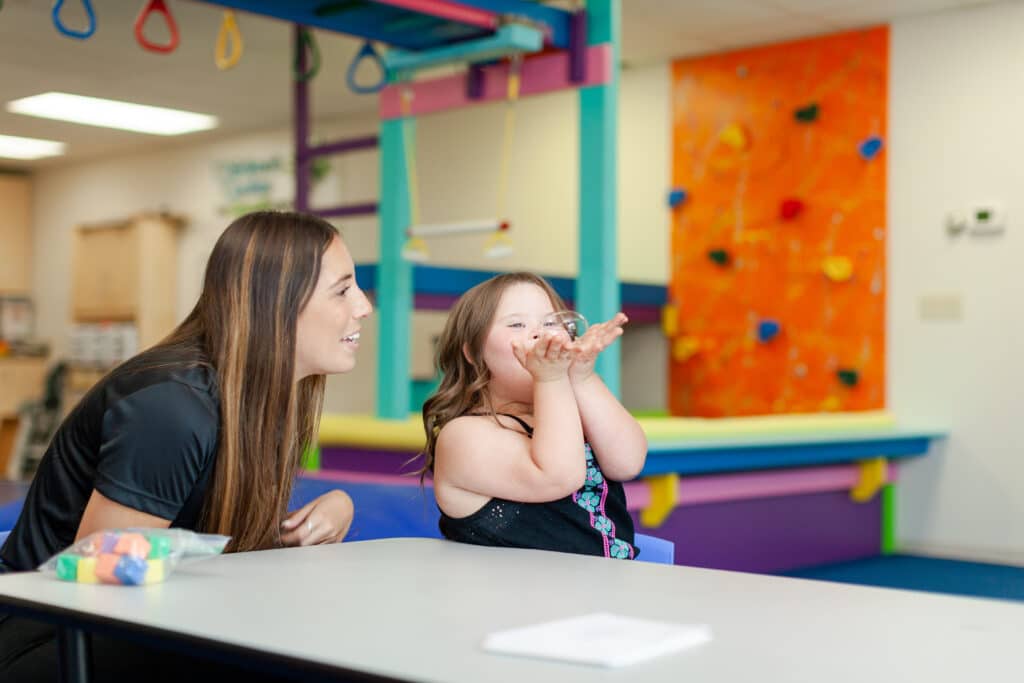A common misconception surrounding American Sign Language is that only individuals in the Deaf Community use it. However, sign language can be used for children who are non-verbal and require other methods of communication, including children with Autism, Down Syndrome, Cerebral Palsy, and other diagnoses that are often accompanied by speech delay. There is also another method of American Sign Language used for infants as young as six months old called Baby Sign Language. Baby Sign Language includes simple gestures for parents to teach their babies so they can better understand their child’s needs and so their child does not become frustrated when others do not understand their speech.
Many parents wonder if teaching their child sign language will hinder their speech development. So, ? Research has shown that using Baby Sign Language can, in fact, increase a child’s speech skills. Research has also shown that incorporating Baby Sign Language in your child’s speech can prevent social and emotional regulation issues, as your child will be able to communicate through signs when their speech may not yet be fully understood by you or others.
At what age can babies learn sign language?
You can start teaching your baby sign language as early as six months old. At this age, babies often begin to develop the ability to make hand gestures. You can start by introducing one at a time to your and preferably begin with that will develop their skills.
Each family has its own unique needs and there may be some signs that are more beneficial to incorporate into your specific routine. A child, for example, who is attached to their bottle may pick up the sign “bottle” or “milk” quicker than the sign for “hungry.”
Some signs that may be beneficial for your family include:
- Milk – teaching your child this sign will allow them to express when they are hungry, especially if milk, or a bottle, is their source of food.
- Hungry – teaching your child this sign will allow them to express when they are hungry, this sign can be used for bottle, breast, or solid foods
- More – if your child wants more of something they can tell you, rather than having you guess if they want more or are done with their food or activity.
- All Done – this sign will allow your child to tell you or another caregiver they want to stop doing something without crying. For example, they can share when they are done with their meal, a toy, or bath time.
- Poop – this sign will be helpful when your child is aware they had a bowel movement and is in need of a change, or they are old enough to know they need to have a bowel movement and are communicating their need to go to the restroom.
- Help – this will allow your child to request your help rather than you guessing if that is what they need. This will also allow your child to build their independence with activities and when they are unable to do the task, they can then ask for help.
- Mom or Dad – these signs allow your child to tell others they want their mom or dad. They can also use this sign to get your attention when talking with you.
- I love you – how fun would this be for you and your child to tell you they love you before they are verbal?
Learning and Teaching Sign Language
can be challenging. However, you can find many helpful videos and demonstrations by searching for “baby sign language.” If this is something you will frequently use, there are apps available for your phone or mobile device for learning more signs and steps on introducing new signs to your child. You can talk with your speech therapist about apps they recommend to teach Baby Sign Language to your child, or signs they would recommend incorporating into your child’s daily routine
It is recommended that parents show the sign while speaking the associated word to their child, so their child begins to understand the word as they hear it, and the sign by seeing it. While the child may not yet be able to repeat the word, they will begin to associate the sign with the object, person, action, etc. Do this several times while slowly repeating the word with the sign. Once the sign has been introduced to your baby, it is important to begin encouraging your baby to start using the sign on their own. You can do this when your child is indicating they want their bottle by guiding the child’s hand to sign the word “milk” before giving them their bottle. This will take some time for them to fully comprehend the pattern, but before you know it, they will be doing it all on their own!
Are there long-term benefits to using baby sign language?
While there is more research that needs to be conducted before determining the long-term benefits and effects of using Baby Sign Language, the research on short-term effects is promising. Short-term benefits include your young child developing the ability to have a conversation with you and other caregivers. This ability to initiate conversations and continue conversations will strengthen the bond between a child and their caregivers.
Teaching a baby sign language skills will also strengthen their ability to begin practicing using words and phrases that they otherwise would not normally be able to do until they are quite a bit older, usually until they are able to speak with words.
Typically, who are able to develop the ability to communicate at such a young age will build stronger verbal communication skills when it is appropriate, and they will also be more comfortable conversing with others.
What are the disadvantages of baby sign language?
The most common disadvantage of using baby sign language is when caregivers are unfamiliar with how to teach it or use it appropriately. It is important that caregivers are, first and foremost, patient with their child, and also themselves, while beginning to introduce baby sign language.
Remember to introduce the sign while also speaking the word to your child, and then guide your child’s hand to mimic the sign when they are indicating the need for something related to a sign you have shown them. If you want your child to use Baby Sign Language then it is important for you to remain consistent in teaching each sign with spoken language as previously discussed.
It is also recommended to introduce only a few signs at a time until the child has mastered the previously taught signs. Showing too many signs at once may confuse the child or frustrate all parties involved because it is too much to remember or help with carryover. Another reason to only introduce a few signs that is your child is developing fine motor skills during this early stage of life, and it may be difficult to understand the specific sign they are trying to use. Try to introduce signs that look different from one another so it is easier for the child to differentiate and for you, or other caregivers, to easily understand what they are trying to communicate. Again, be patient with yourself and your child, as this will be a new learning experience for both of you. Baby sign language development will show benefits with repetition and time.
Pediatric Speech Therapy Can Help
Obtaining a prescription for pediatric speech services may be beneficial to you and your child if your child is not developing age-appropriate speech skills or you are having difficulty understanding their speech. Our speech therapists can provide you with resources and suggestions for home to help your child build their speech skills, whether they are verbal skills or gestures like signs. They can also provide you with recommendations on which signs may be the most beneficial to introduce to your child and begin incorporating into your daily routine.
If you have any concerns regarding your child’s fine motor development or school readiness, don’t hesitate to contact an Ivy Rehab Network clinic to provide you with more information. Visit our website to request an appointment online or contact the location nearest you for additional information.
Article By: Hannah Ardelean PTA
Hannah began her Physical Therapist Assistant career just over one year ago. Hannah loves working with the Pediatric population and believes in the importance of providing evidence-based, quality, direct care to her patients. She currently holds certification to provide Serial Casting at her clinic. Hannah enjoys working with children of all ages and watching them achieve their goals and educating their parents on how to be an advocate for their children. She currently treats patients at Ivy Rehab for Kids in Davison, MI.





